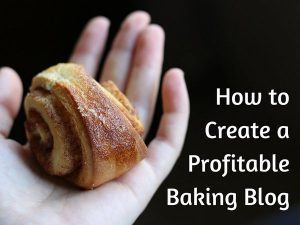 Do you have a passion for making pastries and sharing them with your friends? Don’t you wish you can do much more than covering yourself with flours in the kitchen? Then it’s time to explore the pastry world, which happens to be very huge, on the internet.
Do you have a passion for making pastries and sharing them with your friends? Don’t you wish you can do much more than covering yourself with flours in the kitchen? Then it’s time to explore the pastry world, which happens to be very huge, on the internet.
In this week’s tutorial, I will show you how to start a baking blog and make a profit with very little investment.
How to Start a Baking Blog in 5 Steps
Step 1 – Niche Research
The first thing you need to find out is what kind of audience you want to target online. Ask yourself, who would be interested to read from your website?
Understanding the behavior of your niche will give you some ideas on what content to write later on. Let’s do some brainstorming, shall we?
- Stay at home moms
- People who are working in the baking industry
- Students who are interested to start a baking career
- People who like to bake as a hobby
- People who have food allergies, but still love to make pastries
And the list could go on. There’s always a general misconception that baking is only limited to the female audience and although the statistics are true to some extent, the list above clearly shows how diverse this niche can expand.
Drawing information from each of the groups, you can now come up with products and services to offer through your blog.
- Baking supplies and equipment
- Recipe books/ ebooks
- Baking courses
- Baking ingredients
- Baking techniques
With these ideas in mind, it’s going to be a whole lot easier to search for affiliate programs to work with.
Step 2 – Search for Affiliate Programs
The most popular marketplace that people shop online is Amazon and through their affiliate program (aka the Amazon Associates), your sales commission starts from 4%. The good thing about Amazon is that they have a ton of baking products that you can recommend and since people usually shop more than one item, you earn a commission from other purchases too.
Here are just some of their product categories to choose from.
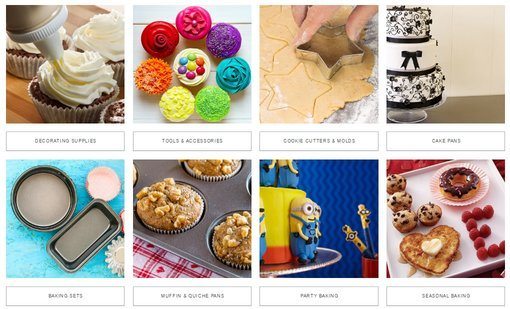
However, Amazon isn’t your one and only choice. If you are looking for something different, you can search within affiliate networks for other brands. For this purpose, I like to use the Jaaxy Keyword Tool to search as they allow me to use keywords to look up for merchants easily.
All you need to do is to type in a keyword, select the network and a list of merchants and their sales commissions will be displayed for comparison.
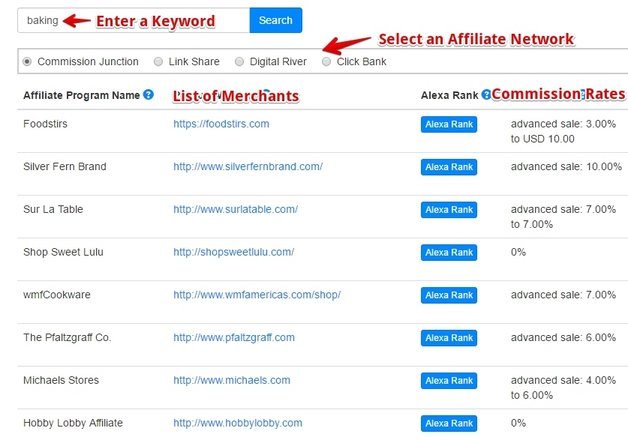
The third method for finding affiliate programs is to use good old Google Search. Some of the results belong to private affiliate programs, which means the commission rate could be a lot higher. This is how you would type on Google Search – “keyword” + affiliate program, just like the example below.

Below is a list of affiliate programs that I’ve compiled for your reference from this searching technique.
- Minimalist Baker
- Sweet Baking Supply
- The Prepared Pantry
- Kitchen Krafts
- Pretty Witty Cakes
Step 3 – Create a Domain and a Website
To monetize from a blog, it’s always best to go with a paid website, which means buy a custom domain and pay for a good quality hosting service. That way, you’ll have more control over your business brand and get professional support on web issues when needed.
I personally like to use SiteRubix because their fee is all-inclusive, affordable and the technical team is very efficient. For a custom domain, like the example below, you only need to pay $13.99/year which includes privacy protection, backups, and email address.

After that, you can create a WordPress website with just a one-click installation. For more information about the hosting features, check out the Wealthy Affiliate online business tools here.
Step 4 – Keyword Research and Content Structure
Keyword research will be the basis of your blog creation. In a more simple perspective, your articles will be written to address the questions/ concerns/ problems/ needs of a baking niche. In order to do that, you’ll need to know what type of keywords (a.k.a queries) that are being searched online.
Here’s where a keyword tool like Jaaxy comes in. When choosing for keywords/ keyphrases, you need to make sure that they meet these criteria;
- The phrases make sense
- They are descriptive and convey intentions
- They have low competition on the search
Before we dig more into that, let’s split your blog into two sections – the page and the post. Pages are generally evergreen topics that will not go out of trend and they are often the point of reference for other articles. Here are some evergreen keywords examples;
- Baking Tips for Beginners
- Why Baking Is a Healthy Hobby
- How to Clean Your Bakeware
- The Advantage of Making Your Own Bread
Posts, on the other hand, are the blog topics that you’ll be publishing on a regular basis. The content is usually more trending and it’s what you would use to funnel readers to your main product reviews. Here are some blog keywords examples;
- Can Garlic Bread Be Made Ahead Of Time
- Fun Ways to Make Chocolate Chips Cookies
- Chicken Pie Recipe for Toddlers
- Where to Buy Egg Tart Mold
For starters, you should have at least 3 pages and from these, you would gradually branch out into subtopics that would become your blogs. Am I confusing you already? Let me put it into a flow chart for you.
Baking Tips for Beginners (an introduction page for your readers)
↓
Where To Buy Baking Supplies (guiding readers to get started)
↓
Baking Supply X Product Review
Writing articles in this manner will make you less of a product pusher and more of a marketer who’s knowledgeable and helpful and readers love to hang around blogs like that. The upside is that the more they learn, the more interested they would be in buying a certain product through your recommendation.
Step 5 – Write Engaging Articles and Share
After all the research, it’s time to write out the articles. For the first two hours, just blast out whatever you have in your mind into the word publisher. Don’t aim for perfection and don’t let the writer’s blog stop you.
Once you have completed the draft, revise the content, add images/ videos/ infographics to create some visual impact and get someone to proofread it.
Once it has been published, get other bloggers to leave some comments as this will create good engagement for the blog. I like to use SiteComments because the comments that I usually get are genuine and diversified. On top of that, I can determine how many and when I want the comments to be delivered so that it adapts to my blogging routine.
Here’s how I submit my blog for comments on a weekly basis.
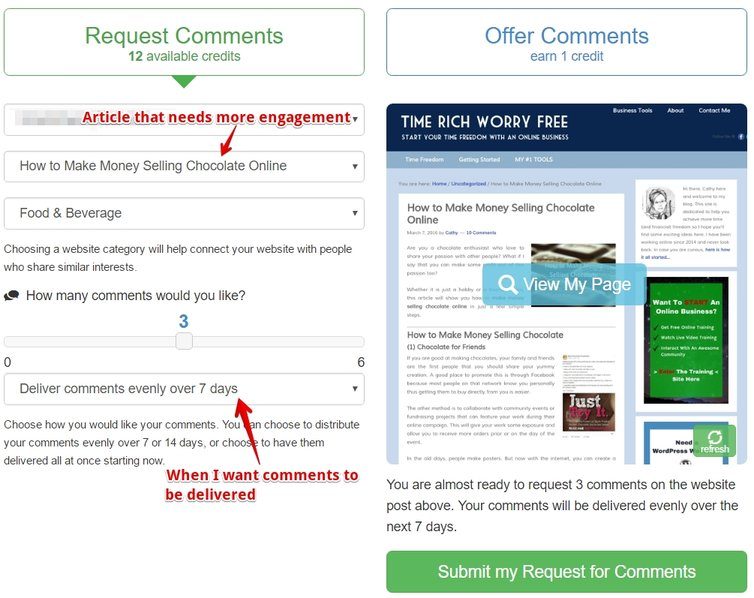
Right after that, hop over to your favorite social networks and share your blog posts. From experience, I found that Google Plus, Facebook and Pinterest are popular with the food/baking communities because their threads are more visually engaging. So that’s something for you to think about.
Having completed this step, now you just need to write engaging content on a consistent basis, drive traffic to your blog and make recurring sales commissions as a result of that.
Turn Your Passion Into Profit
Remember I mentioned that baking is huge on the internet? Just look at the trend of people going online to learn “how to make pastry” over the years (and that’s only one type of keyword). If you can position your blog amid this upward trend, there is really no limit to what you can achieve in your online business.
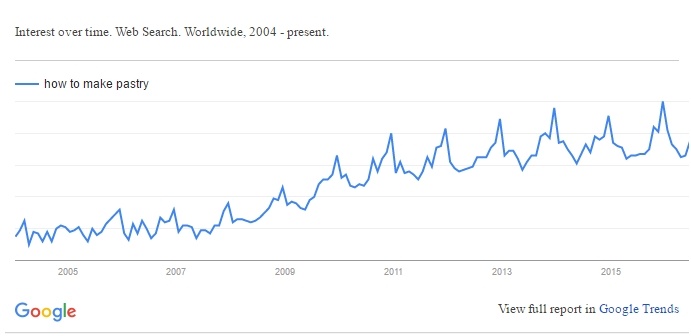
So, are you excited about this niche opportunity? Check out my recommended training platform to learn how to start a baking blog today. I’ll be there to help you out too so see you on the other side.
Do you have any thoughts or questions about this topic? Feel free to leave your comments below and I’ll get back to you.

Hi Cathy,
I really enjoyed reading this post on starting a bakery blog. It’s great, I even have banana bread baking in the oven right now as I am typing this. My girlfriend would actually love this wonderful idea – she’s always baking something different every weekend. I can’t wait to check out more of your site. Keep up the awesome work!
My family has a very old and coveted monkey bread recipe. My mom initially turned her monkey bread baking skills into a hobby, but she couldn’t figure out how to get enough income, and create enough time to commit to it. She is also a full time teacher. I’m going to show her this article. It may light some fire under her again and provide a sort of plan on how to go about it.
Cathy,
I am loving your tips on how to start a blog in the baking niche. I’ve seen a lot of your series of posts on affiliate marketing in different niches and like your way of showing us how to do market research and seeing for ourselves if the niche is worth pursuing or not.
Baking looks like a broad niche with a lot of potential. And of course, the best place to learn online marketing would be Wealthy Affiliate. 🙂
Thanks for sharing.
Hi Cathy
I really like the way you explain how to start from an interest in baking to making a website and how to start that site to make money.
I love to bake when I get the time, which is not so much now with balancing work and family life, but I aim to do more online work to get my time freedom back. And I really love the idea of turning an interest like this into a business.
If baking is not the thing I want to pursue, how can I discover what is trending higher for another interest I have like you show in your graph? Thanks.
Hey there Wade,
If you are looking to find what is trending in your niche, I highly recommend that you check out Trendhunter. It delivers the latest products/innovation from all over the world and I am sure you’ll find something that you are interested in. Cheers!